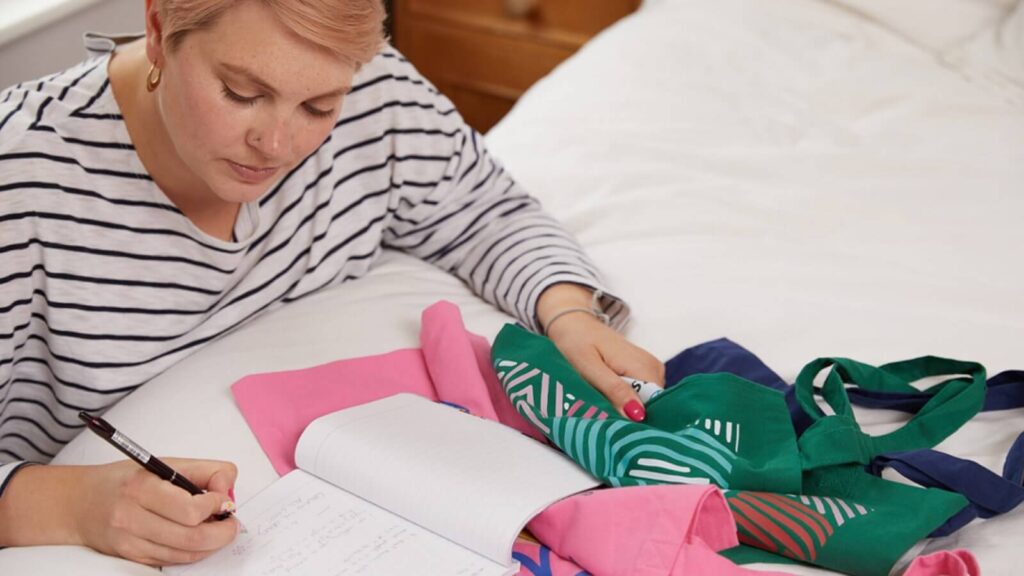How to start a Clothing brand: My 11 Steps Guide
Blog Created By Alberto Miller
This Blog May have Affiliate Links Inside
Thinking about launching your own apparel label? You can introduce a credible name offering top-tier personalized clothing without needing a physical storefront or bulk inventory.
This walkthrough outlines launching a fashion label in easy-to-follow stages. We’ll cover online store essentials, garment varieties, cost-effective business models, promotional tactics, and professional advice on building a home-based fashion enterprise and transforming the modern retail shopping experience.
Key takeaways
- Versatile operational frameworks: On-demand printing, dropship fulfillment, private-label manufacturing, bulk wholesale, and internal production each carry distinct investment demands and oversight levels.
-
Consumer analysis: In-depth market surveys help you identify your audience, their preferences, and emerging trends.
-
Strategic blueprint: A business plan rooted in market intelligence, unique selling propositions, and financial forecasts will position you for success.
-
Craftsmanship and aesthetics: Ordering prototypes lets you assess product quality and ensure your signature designs truly stand out.
-
E-commerce setup: Many online marketplaces and platforms exist for building your web-based storefront.
- Marketing tactics: Social media, email outreach, and influencer collaborations will widen your brand’s reach among prospective customers.
Why start an online clothing business
- Minimal startup expenses: Launching an internet venture demands lower initial funding than a conventional storefront, making it a more attainable choice for entrepreneurs working with tight budgets.
-
Versatility and convenience: Running an online store has become automated, so you can enter the apparel market anywhere at any time.
-
Worldwide exposure: Owning an online clothing label lets you reach buyers across the globe, broadening your market and boosting sales potential.
- Effortless management and scalability: Online ventures can be overseen and expanded more easily than physical businesses, allowing you to grow your apparel enterprise efficiently.
1. Understand your market
- Define your ideal customers: Specify whom you aim to connect with through your digital apparel boutique. You might segment based on demographics like age, gender, region, hobbies, or income bracket.
- Gather feedback via surveys and interviews: Reach out to prospective buyers and inquire about their style choices and buying routines. Employ online questionnaires, face‑to‑face interviews, or focus panels to collect these insights.
- Study fashion patterns: Leverage resources such as Google Trends to explore contemporary style movements and industry shifts, uncovering chances and obstacles. This insight enables you to design apparel that resonates with shopper tastes.
- Observe rival brands: Watch competitor offerings closely, noting their merchandise, price structures, advertising campaigns, and distribution methods. Doing so allows you to set your collection apart and sidestep frequent errors.
2. Select a business model
There are a number of business approaches to explore when launching a clothing label. Each method offers advantages and disadvantages, and the ideal option hinges on your objectives, budget, and customer base. Now, let’s examine the key online apparel shop business structures.
The print-on-demand approach
Design bespoke apparel via a POD service such as Printify and showcase your items on leading e‑commerce platforms like Etsy or Shopify. Once an order is placed, Printify’s network manufactures and delivers the garment straight to the buyer. Your responsibilities include supplying artwork and promoting your brand.
| Pros | Cons |
|---|---|
| Low startup costs | Limited control over quality |
| Customizable and unique products | Dependence on the POD platform |
| Easy setup | Time and effort in creating designs* |
| Pro | Cons |
|---|---|
| No inventory investment | Lower profit margin |
| Easy to set up and manage | Limited control over fulfillment and service |
| Wide range of products | Dependence on supplier reliability |
Private-label or white-label manufacturing
Partner closely with a reputable clothing producer to launch your brand. Develop original designs or personalize the factory’s offerings under your label, then purchase bulk orders and distribute directly through your e‑commerce store. This yields improved profit margins and enhanced oversight of production standards.| Pros | Cons |
|---|---|
| Higher profit margins | Requires significant investment |
| Greater control over quality | Less control over product designs |
| Branding opportunities | Strong manufacturer relationships needed |
Selling wholesale
Buy products wholesale in quantities from suppliers and retail them through your online store at a markup. You will oversee stock levels and process shipments. This strategy yields higher profit margins but demands adequate capital investment upfront.| Pros | Cons |
|---|---|
| Higher profit margins | Requires investment in inventory |
| Control over inventory | No customization |
| Access to unique products | Risk of unsold stock |
Making your clothing
| Pros | Cons |
|---|---|
| Complete control over quality | High startup costs |
| Unique product offerings | Must make all clothing by hand |
| Personalized branding | Longer production times |
3. Write a business plan

Market research. This part must present comprehensive investigation into your intended audience, covering consumer segments, tastes, and apparel sector buying behavior.
Differentiators. How does your fashion label distinguish itself from rivals? It might involve distinctive design, eco-friendly fabrics, or a community-focused or ecological commitment.
Production and distribution. Describe your manufacturing workflow, covering procurement, production methods, and shipping logistics. Include details on your fulfillment model and the channels through which you will deliver products to consumers.
Financial forecasts. Present estimates for income, costs, and net earnings, helping you gauge your e-commerce apparel venture’s expected overall monetary outlook.
Even if you launch a small fashion label, a detailed business plan will help you organize your ideas and prepare you for genuine success. It serves as an outline of your objectives, tactics, and implementation steps.
A prepared business plan enables you to convey your vision to prospective investors, collaborators, and clientele. It also functions as a guide for your apparel venture’s expansion and advancement.
Be sure to incorporate these essential elements into your business plan:
4. Choose a business name
Stay distinctive. Your business name needs to differentiate itself from rivals and stick in potential customers’ minds. Avoid common or overused words already adopted by other brands in your market.
Emphasize your identity. It should reflect your brand’s core values and what makes it uniquely stand out from competitors.
Verify availability. Prior to finalizing a business name, confirm its availability and trademark registration to prevent legal complications.
5. Acquire a business license
- Decide your business structure. Select an organizational form that aligns with your objectives and operational needs, whether that is a sole proprietorship, partnership, or corporation. This choice influences your venture’s legal obligations, tax implications, and the steps required to secure a business license.
- Register your company. Complete registration with your municipal or state authority, which typically involves submitting an application and covering any associated fees. Establishing a formal entity shields your personal assets by separating them from business liabilities.
- Obtain permits and licenses. Depending on your operations and location, you might need to secure necessary extra authorizations. This might encompass permits for retailing items, utilizing particular materials or functioning in designated areas.
- Adhere to regulations. Ensure that your apparel enterprise complies with every applicable rule and statute, covering taxation, employment, and all safety standards. This will help you prevent legal problems down the road.
You don’t have to form an LLC (Limited Liability Company) to launch your own clothing label or open fashion retail outlets, but it may deliver distinct key advantages.
- Liability coverage. An LLC provides personal liability safeguards. Thus, if your clothing brand faces legal claims or accumulates debts, your personal assets, for the most part, remain protected.
- Professionalism and trust. An LLC may boost confidence among customers, suppliers, and potential investors in your brand.
- Separation of private and business funds. An LLC helps maintain a clear boundary between personal finances and company-related matters.
6. Create unique designs

This marks a pivotal phase in discovering how to launch a fashion label without prior experience. Original concepts decide if you truly possess the ability to distinguish yourself within the competitive apparel industry.
Use these guidelines to bring your vision to life:
Determine your brand’s core identity. Define your brand’s unique characteristics, including aesthetic style, mission statement, core values, and target demographic audience. This will serve as the foundation for your design process.
- Sketch your ideas. Use pencil and paper to sketch initial detailed design ideas, or begin with online illustration tools. Experiment with concepts, visualize designs, refine details continuously, and seek feedback whenever possible.
- Create product mockups. Use Printify’s Product Creator or other mockup libraries like PlaceIt to view your concepts in a real-world context. If you are happy with the result, save and organize mockups for later when preparing products and connecting them to your storefront.
- Collaborate with a designer or manufacturer. Work together to bring your designs to life with prototypes or samples to check quality and apply adjustments. If you don’t know any designers personally, use platforms like Fiverr to hire a freelance fashion designer or technical artist to create high-quality artwork for you.
7. Find a clothing manufacturer
Explore potential factories by reviewing different Print Provider ratings in the Printify catalog. Alternatively, consult online directories and industry publications or obtain referrals from other apparel designers in the Printify POD Rockstars Facebook group.
8. Check the quality of your product

9. Choose a sales channel
- Online marketplaces. Platforms like eBay, Amazon, and Etsy enable you to sell your items to a broad, diverse audience of potential buyers across the world. Such marketplaces offer an immediate online storefront but often carry significant fees and face fierce competition.
- eCommerce platforms. Services like Shopify and Wix allow you to build your online store and sell products directly to customers. These platforms include various tools, templates, and functionalities designed to help you oversee and expand your venture, but they may demand a greater degree of technical skill and know-how.
- Your own eCommerce website. Building an eCommerce site from the ground up provides complete authority over your digital presence and the shopping experience for your audience. This strategy can strongly reinforce brand identity and foster direct engagement with buyers, yet it often involves a substantial commitment of time, effort, and resources. Printify’s Custom API can prove beneficial if you choose to pursue this path.
Ultimately, choosing the right sales channel for your apparel brand depends on your business objectives, budget, and target market.Take time to research and compare various channels so you can identify the best option for your needs.
10. Price your products right
Setting your product pricing is essential for the prosperity of your apparel brand.
You need to balance profitability with effectively offering appealing prices that attract customers to your products.
Research your target market and competitors to identify a pricing range that is both fair and sustainable.
When determining how much to charge for your clothing collection, a rule of thumb is to add at least forty percent above the estimated production cost.
Evaluate your expenses. Work out the total cost to manufacture and distribute your items, factoring in raw materials, workforce, and overhead costs. This analysis will reveal the lowest price point you must set to secure profit.
Experiment with pricing. Try various price points to observe how they influence purchases and client reactions. You may leverage web platforms or services, like Optimizely, to run A/B experiments and measure how different price options perform.
Revise pricing regularly. Keep track of how your pricing holds up over time and tweak it when necessary. This might involve responses to shifts in customer demand, market rivalry, or cost fluctuations.
Provide free delivery. Waiving shipping fees is a classic promotional strategy and a leading incentive for buyers globally. Roll shipping charges into the item’s sticker price. Shoppers are more inclined to spend $69 on a sweatshirt than $59 plus a $10 delivery fee.
11. Begin marketing and selling your custom apparel
Drive awareness and interest in your clothing brand using these methods:
Establish a brand persona. Craft a distinctive and cohesive persona that embodies your apparel collection’s character and differentiates it from competitors. This involves aspects like your emblem, color scheme, messaging style, and visual motif.
Interact with your audience. Engage with your audience through social media channels, email newsletters, and your online platform to nurture connections and cultivate a community centered on your apparel brand persona. This approach enables you to collect feedback on your audience’s tastes and expectations and boost engagement and repeat business.
Team up with brand ambassadors. Collaborate with ambassadors whose image aligns with your brand persona and who attract potential buyers. Ambassadors can assist in showcasing your apparel collection to their followers and sparking enthusiasm.
Provide deals and incentives. Motivate buyers to select your apparel by offering irresistible deals. This may involve regular sitewide markdowns, welcome discounts for new shoppers, loyalty reward schemes, or referral incentives that grant benefits to existing customers for recommending others.
Print On Demand Q&A
1. What is POD and how does it function?
Print-on-Demand (POD) is a fulfillment model where products (like t-shirts, mugs, or posters) are manufactured only after a customer places an order. You upload your design to a POD platform, they handle printing, packaging, and shipping—so you never hold inventory.
2. Can you make money, and what’s the earnings potential?
Yes. You set your own retail price above the base cost, so every sale yields profit. Earnings vary widely—beginners often make $100–$500/month, while top sellers can pull in $5,000+/month by optimizing designs, marketing, and niches.
3. How to Master Print On Demand?
Master POD in three simple steps:
1. Follow Our in-depth blog tutorials to nail Useful Insights and basics.
2. Get the Free Print On Demand Guide
3. Leverage the Our Weekly Insights, Guides, Templates and News Send to you every week.
Join Over 500+ Print on Demand Creators Now
4. What is the Best Site for Print On Demand?
Printful is the top choice for most sellers:
• Seamless Integrations: Connects instantly with Shopify, WooCommerce, Etsy and more.
• Product Variety: 200+ items—from apparel to home décor.
• Global Fulfillment: Print centers in North America, Europe, and Australia cut shipping times.
• Built-In Tools: Free mockup generator, branding options (pack-ins, custom labels) and design editor.
• No Minimums: Pay only when you sell—zero upfront inventory costs.
Start Earning With Printful Now!!
5. How much money or technical skill do I need to start?
Budget: $0–$50 to set up (free POD account + optional design tools). Paid ads or premium mockup software add cost later.
Skill: Basic computer literacy. For design you can use free tools like Canva or hire freelancers. Integrations with Shopify/WooCommerce require minimal technical setup steps—no coding needed.








0 Comments